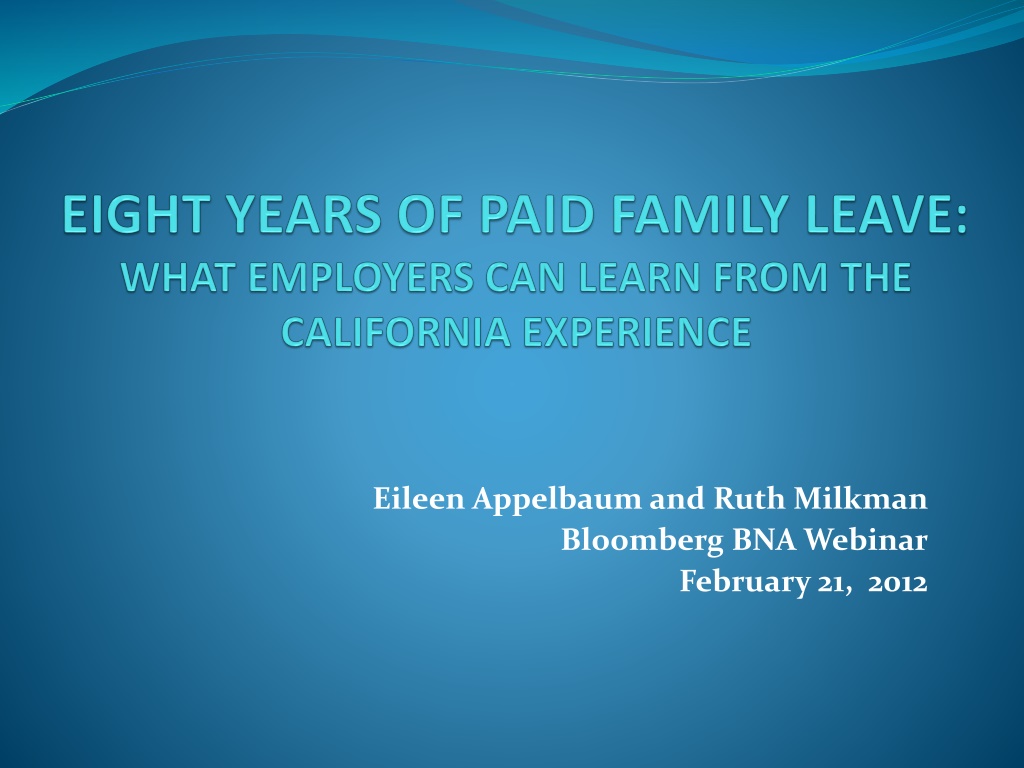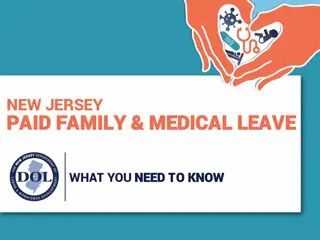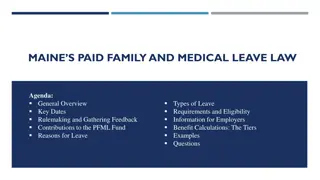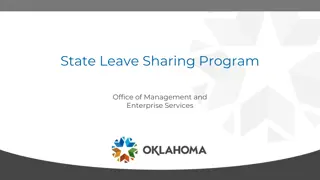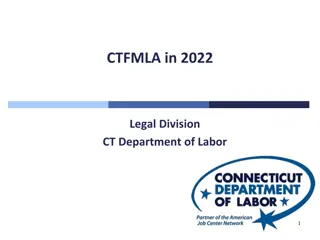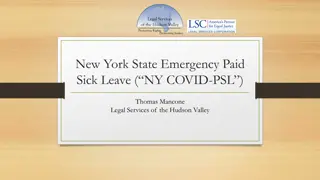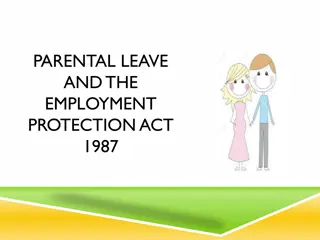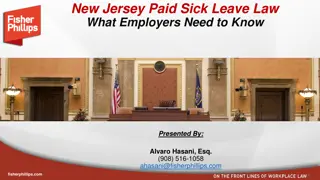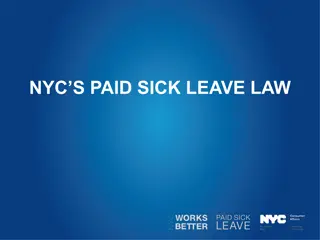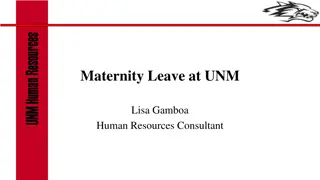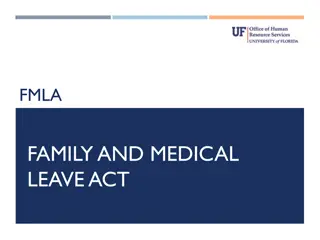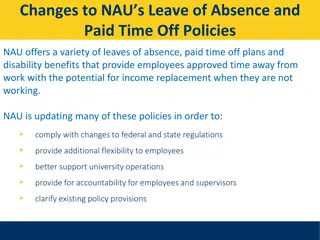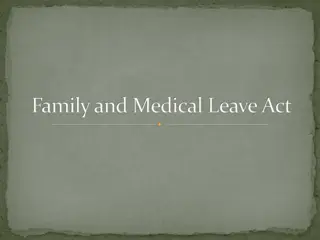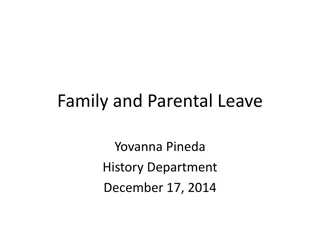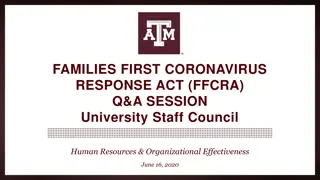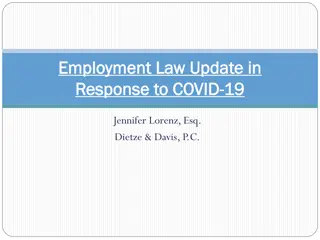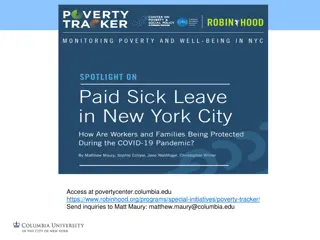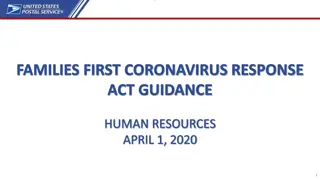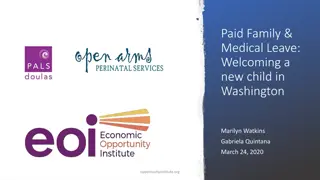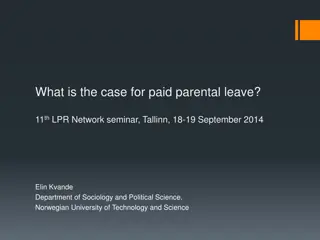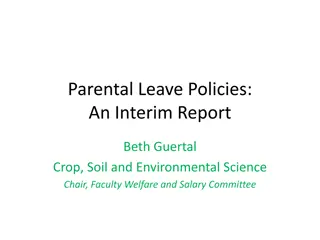Understanding California's Paid Family Leave Program
California's Paid Family Leave (PFL) program is the first of its kind in the nation, offering up to six weeks of wage replacement for parental bonding or caring for a sick family member. It operates on an insurance model funded by a payroll tax, providing benefits to nearly all workers in the private sector, regardless of employer size. Eligibility is broad, and the program caters to the diverse needs of employees, ensuring job protection and support for work-family balance.
Download Presentation

Please find below an Image/Link to download the presentation.
The content on the website is provided AS IS for your information and personal use only. It may not be sold, licensed, or shared on other websites without obtaining consent from the author. Download presentation by click this link. If you encounter any issues during the download, it is possible that the publisher has removed the file from their server.
E N D
Presentation Transcript
Eileen Appelbaum and Ruth Milkman Bloomberg BNA Webinar February 21, 2012
AGENDA Overview of California s PFL Program Comparison with New Jersey FLI Program Business Impact of California Program Myths and Realities: Mandates, Costs, Employee Abuse Future Prospects for Work-Family Legislation
U.S. WORK-FAMILY POLICIES U.S. notoriously lacking in public policies that support workers who need time off to attend to family needs Only major legislation: 1993 federal Family & Medical Leave Act (FMLA) Guarantees up to 12 weeks of job-protected leave to workers for own medical condition or for family care Eligibility requirements mean only about half of all workers are covered, less than a fifth of new mothers Unpaid so many who need leave can t afford to take it 5 states (CA, NJ, NY, RI, and HI) & Puerto Rico have temporary disability programs that also cover pregnancy and recovery from childbirth
CALIFORNIAS PAID FAMILY LEAVE PROGRAM First in the nation passed 9/02, took effect 7/04 Insurance model, like temporary disability A 1.1% payroll tax funds both SDI + PFL Fully employee paid; no employer contribution Employers can coordinate own benefits & PFL Cannot require employees to use PFL, but employers with generous benefits tend to encourage its use
ELIGIBILITY FOR CALIFORNIA PFL Eligibility is nearly universal: Covers entire private sector regardless of employer size Self-employed and unionized public-sector workers can opt in Workers need not have been with current employer for any specific period of time Workers must have earned $300 or more in CA during base period quarter (5 - 17 months before filing claim) Most part - time workers are covered
BENEFITS AVAILABLE UNDER CALIFORNIA S PFL PROGRAM Up to six weeks of wage replacement for baby bonding or caring for seriously ill parent, child, spouse, or domestic partner Up to 55% of earnings w/maximum $987 a week in 2011 (the benefit is taxable) Gender-neutral, both fathers and mothers eligible
NEW JERSEYS FAMILY LEAVE INSURANCE PROGRAM Passed 5/2/08; effective 1/1/09: benefits paid 7/1/09 Covers all private and government employees Notice requirements At least 30 days notice for bonding after birth or adoption except for unforeseen circumstances Sick family member try to minimize disruption 15 days for intermittent leave Benefits modeled on California s PFL Program
NEW JERSEYS FLI PROGRAM Eligibility Based on earnings in 52 weeks preceding family leave Must have earnings in those 52 weeks of 1,000 times the state minimum wage ($7,300), OR At least 20 times the minimum wage ($145) per week during each of at least 20 weeks during the previous 52 weeks. This makes for wide variation by earnings level: Highly paid worker earning $1,460/week needs a minimum of 5 weeks of work in the 52 weeks to be eligible ($7,300) Low-wage part-time worker earning $145/week needs a minimum of 20 weeks of work during the 52 to be eligible ($2,900)
NEW JERSEYS FLI PROGRAM Insurance model, like temporary disability A 0.06% payroll tax on first $29,600 of earnings funds FLI ($9 to $18 annual cost) FLI fully employee paid; no employer contribution Disability insurance 0.5% payroll tax on employers and 0.5% payroll tax on employees on first $29,600 (since 1940s) Employers may not coordinate their own benefits with FLI Employers opposed letting employees collect benefits from employer and FLI at same time; this had unanticipated negative consequences for employers
BENEFITS AVAILABLE UNDER NEW JERSEY S FLI PROGRAM 6 weeks of wage replacement for baby bonding or caring for seriously ill parent, child, spouse, or domestic partner Up to 67% of earnings w/maximum $559 a week in 2011 (benefits are taxable) More generous to low-wage workers than the California PFL program, but less generous to highly paid workers Gender-neutral, both fathers and mothers eligible
OUR RESEARCH Telephone surveys before and after the passage of PFL California businesses (N = 250) California workers with PFL-eligible family events (N = 500) Site visits and fieldwork with convenience samples of employers in both California and New Jersey
2010 SURVEY OF CALIFORNIA EMPLOYERS Conducted in 2010 6 years of experience with PFL Sample of 253 establishments drawn from Dun & Bradstreet database Included private companies and non-profit organizations Stratified by size, to examine effects on small as well as larger businesses Results were weighted to adjust for overrepresentation of large firms in sample, and for nonresponse Managers or owners were interviewed by telephone
2010 SURVEY OF CALIFORNIA EMPLOYEES Screening survey of 500 individuals Screened to include individuals who had experienced an event that could have triggered a paid family leave New child Seriously ill family member Not a representative sample, but demographically diverse includes a wide range of pay levels Telephone interviews, in Spanish and English
BUSINESS CONCERNS RE PFL In both states, business lobbyists campaigned against the legislation Chamber of Commerce lobbying led to scaling back the original California proposal (wage replacement for up to 12 weeks, with costs shared between employers and workers) Business voiced concern over costs of covering the work of those on leave, and about potential abuse Claimed burden would be especially difficult for small businesses
REPORTED IMPACT OF PFL ON CALIFORNIA EMPLOYERS 89% of CA employers surveyed said PFL had no noticeable effect or a positive effect on productivity 91% said it had no noticeable effect or a positive effect on profitability 93% said it had no noticeable effect or a positive effect on turnover 99% said it had no noticeable effect or a positive effect on morale
FEWER NEGATIVE EFFECTS FOR SMALL THAN LARGER COMPANIES No noticeable effect or positive effect on: Productivity Profitability/performance Turnover Morale N=175 Less than 50 Employees 88.8% 91.1% 92.2% 98.9% 50 99 Employees 86.6% 91.2% 98.6% 95.6% 100+ Employees 71.2% 77.6% 96.6% 91.5% All Employer Respondents 88.5% 91.0% 92.8% 98.6%
PFLS EFFECTS ON TURNOVER Employers reported positive effects of PFL on turnover Further evidence that PFL reduces turnover comes from employee survey Use of PFL greatly increases likelihood that workers will return to same employer after leave Employee survey: 83% of those who used PFL returned to same employer, compared with 74% who did not use PFL; Among non-exempt workers 95% who received full pay while on leave returned to same employer, compared with 88% who got partial pay, and 69% who got no pay pay
JOB QUALITY AND EMPLOYEE TURNOVER Screening survey analysis compares employees in high- quality jobs ($20/hr + health benefits) with those in low- quality jobs 30% of sample were in high-quality jobs Half of workers in high-quality jobs had access to full pay during leave from employer, did not use PFL But highly likely to return after family leave Many workers in low-quality jobs have NO paid time off Employer survey: 67% provide PSD for some employees; 21% for all 85% provide paid vacation for some employees; 36% for all employees
Percentage of Workers Who Returned to Former Employer after a Leave, by Job Quality and Use of PFL, 2009-10 (N=165)
FIELDWORK EVIDENCE ABOUT EFFECTS OF PFL ON TURNOVER Site visits and interviews with managers at 20 businesses in CA and similar number in NJ Discovered most managers, even corporate HR in large companies, do not routinely track costs of turnover Often fail to include all costs when they do calculate it E.g. a large retail clothing chain with 100% turnover does not include cost of recruiters in turnover costs Survey included set of questions from which we were able to calculate organization s cost of turnover
TURNOVER COSTS (our sample) NON-EXEMPT EXEMPT N Average N Average Firm size < 50 89 $5,399 51 $12,625 Firm size 50-499 58 $4,149 49 $13.912 Firm size 500+ 51 $7,987 48 $18,331 Total 198 $5,332 148 $12,887
TURNOVER COST CALCULATOR How much does employee turnover cost your business? Use This Turnover Calculator To Find Out http://www.cepr.net/calculators/turnover_calc.html Turnover is costly, yet many businesses do not track how much it costs them. This turnover calculator provides an estimate of how much turnover costs your organization. Costs often vary for different types of employees. The turnover calculator takes into account variation in wages, weekly hours, and recruiting and hiring costs to calculate the cost of turnover for various categories of workers.
OTHER EFFECTS OF FAMILY LEAVE ON EMPLOYERS ARE MODEST At any given time, relatively few workers go on leave PFL only leads to a small increase in leave-taking Leave length only slightly longer with PFL, except for non-exempt women caring for ill family members Most work of leave takers is assigned to co-workers, at little or no cost to employers But few co-workers report negative effects
EMPLOYER-REPORTED PROPORTION OF WORKERS ON LEAVE (in previous year) Total Firm Size < 50 Firm Size 50-499 Firm Size 500+ 2004 2010 2004 2010 2004 2010 2004 2010 Number of firms 263 253 134 102 65 84 64 67 Parental (median) 1.8% 2.5% 6.7% 7.4% 1.4% 2.1% 1.7% 2.4% Pregnancy (median) 2.5% 6.5% 2.5% 2.0%
MEDIAN LENGTH OF LEAVE - IN WEEKS (employee survey) Baby Bonding Ill Family Member 2004 2010 2004 2010 # leave takers 65 98 33 53 EXEMPT weeks weeks weeks weeks Male 3 3 3 4 Female 11 12 4 4.5 NON- EXEMPT Male 3 3 3 3 Female 12 12 3 5.5
HOW WORK OF EMPLOYEES ON LEAVE WAS COVERED (2010) Exempt Workers Non-Exempt Workers Total Firm Size <50 Firm Size 50-499 Firm Size 500+ Total Firm Size <50 Firm Size 50- 499 Firm Size 500+ Assign Work to Others 76.9% 72.3% 100% 98.0% 89.8% 88.1% 96.8% 100% Hire Temps 39.3% 39.9% 36.8% 27.5% 48.7% 52.4% 32.3% 46.2% Hire Replacements 0.4% 0% 0% 3.9% 2.4% 0% 12.9% 1.9% Put Work on Hold 59.1% 67.5% 15.8% 31.4% 8.0% 6.0% 16.1% 20.8% Workers Do Some Work While on Leave 45.5% 52.0% 13.2% 5.9% 6.6% 6.0% 9.7% 1.9% Some Other Method 15.7% 16.2% 13.2% 11.8% 9.7% 6.0% 25.8% 18.9% * Totals may be greater than 100% because employers can report more than one method
WORKER-REPORTED IMPACTS OF CO-WORKER LEAVE Worker-Reported Rates and Impacts of Co-Workers Taking Leave Total 2004 2009-10 A Co-Worker Has Taken Leave Results of Co-Worker Leave - More Hours - Extra Shifts * - More Duties 56.7% 60.9% 32.5% 22.7% 52.6% 33.0% 51.2% Impact of Co-Worker Taking Leave - Positive - Negative - Neither Positive or Negative 16.1% 10.1% 73.7% 24.7% 6.4% 68.9% * 2009 survey does not ask about extra shifts
FIELDWORK CONFIRMS SURVEY FINDINGS Unexpected family leaves are inevitable, so all organizations have contingency plans Most work covered by co-workers, though for some jobs this is impossible, and costs are incurred. Leave policies improve retention and morale PFL (like FMLA) is a non-event for most employers
FIELDWORK: Examples A multitude of innovative practices are used to minimize impact on operations whenever an employee is absent for more than a few days Examples IT company (< 50 employees) Large hospital Retail and farms Biotech company Large engineering/construction firm Small branch of restaurant chain
THREE MYTHS ABOUT PFL It includes new mandates requiring employers to hold jobs for employees who take family leave It raises employers costs and is a job killer It will be widely abused by employees
NO NEW MANDATES Since 1993, FMLA has required employers with > 50 employees in 75-mile radius to hold job (or similar job) for employee who takes up to 12 weeks of family or medical leave PFL in CA and FLI in NJ are insurance programs. Unless an employee s job is already protected by FMLA or specific state legislation, employer is not required to hold the employee s job Eligible employees are able to collect up to 6 weeks partial income through state PFL or FLI program
SAVINGS FOR SOME EMPLOYERS 87% of California employers reported no cost increases resulting from PFL 9% reported cost savings 60% reported that they coordinated their own benefits for exempt workers with PFL; 58% did so for non-exempts suggests additional savings 13% reported extra costs (hiring, training expenses)
ALMOST NO EMPLOYEE ABUSE After nearly six years of PFL in CA, employers in 2010 survey reported almost no employee abuse of program 91% reported no knowledge of PFL abuse among employees they are responsible for Of the 9% who were aware of abuse, many reported only one instance 99.5% knew of no more than five instances In short, employee abuse is rare
BUT SOME EMPLOYEES FEAR NEGATIVE REPERCUSSIONS FOR USING PFL Over a third were concerned about employer retaliation 31% feared their employer would be unhappy 29% feared it would hurt their prospects for job advancement 24% feared they would be fired In all, 37% were concerned about their employer s response Other reasons 31% felt the PFL benefit level was too low 18% thought it was too much hassle to apply (N= 89; not a representative sample of employees; respondents could cite multiple reasons)
MODEST IMPACT ON EMPLOYERS, BUT LARGE BENEFITS FOR EMPLOYEES Employees who used PFL had higher rates of wage replacement than those who did not with especially strong effects for those in low-quality jobs PFL users were able to take somewhat longer leaves, and were more satisfied with leave length, than those who did not use PFL for their leave PFL users were more likely to return to work for the same employer than non-users Care of new children/ill family members was enhanced by PFL use (2009-10 California employee survey, n=500)
Wage Replacement and Job Quality (High-quality job: over $20/Hr + health insurance) Proportion of Usual Pay Received During Leave High-Quality Jobs Low-Quality Jobs Used PFL Did Not Use PFL Used PFL Did Not Use PFL No Pay 0.0% 11.0%* 0.0% 38.2%*** Less Than Half 0.0% 12.4%** 16.2% 12.5% About Half 55.3% 9.6%*** 25.9% 16.7% More Than Half 37.8% 17.0% 48.2% 10.9%*** Full Pay 6.9% 100.0% 50.0%*** 100.0% 9.7% 100.0% 21.6% 100.0% N=204 Columns may not add to 100.0% due to rounding. *p < .05; **p < .01; ***p < .001, comparing respondents who used PFL and those who did not use it
LIMITED AWARENESS 22% of California adults were aware of new law in fall 2003; 29.5% in summer 2005, 28.1% in summer 2007 Field Poll in summer 2011 found 44.9% of those who voted in 2008 were aware of PFL, compared to 29.7% in fall 2003 who had voted in 2000 Poor enforcement, limited outreach Those who need the program most, are least likely to know about it.
FUTURE PROSPECTS FOR PAID FAMILY LEAVE LEGISLATION Paid family leave Passed in Washington in 2007, but recession hit before funding mechanism in place, so start has been delayed Other states where legislation is being actively pursued include: Arizona, Illinois, Maine, Massachusetts, Missouri, New Hampshire, New York, Oregon and Pennsylvania Obama administration has expressed commitment to advancing paid family and medical leave Obama s 2010, 2011 and 2012 budgets included start-up funds for states that want paid family and medical leave (but funds were not included in final 2010-2011 budgets)
FUTURE PROSPECTS FOR PAID SICK DAYS LEGISLATION Three cities currently have paid sick days legislation Washington, DC San Francisco Seattle Similar legislation seems likely to pass in Philadelphia One state Connecticut passed a paid sick days law
CONNECTICUTS PAID SICK DAYS LEGISLATION July 1, 2011 Connecticut became first state to require employers to provide paid sick days to employees Law went into effect on January 1, 2012 Enables service workers employed in businesses or other entities that employ fifty or more individuals in the state to accrue paid sick leave (of one hour of paid sick leave for each forty hours worked, up to a maximum of 40 hours in one year) Paid sick days are earned by all employees including part-timers
SUMMING UP Paid Family Leave and Paid Sick Days are very popular programs that are likely to be legislated in more states and cities, and perhaps eventually at the national level The experience thus far in California suggests that fears that these programs would prove burdensome to business were mostly unfounded Costs have been minimal, and for many employers these programs bring cost savings Abuse has been minimal as well Overall, a non-event for most employers
